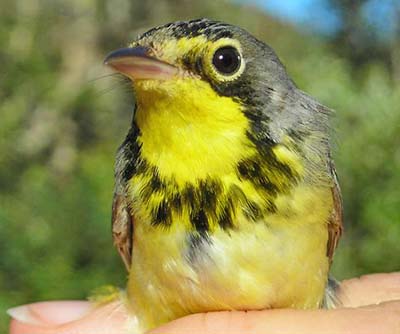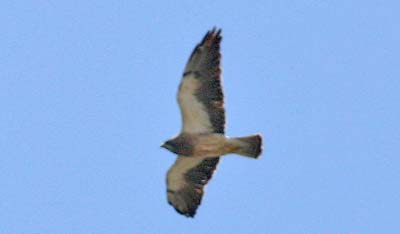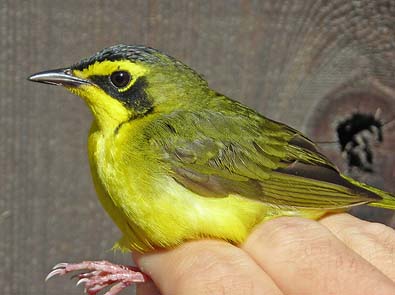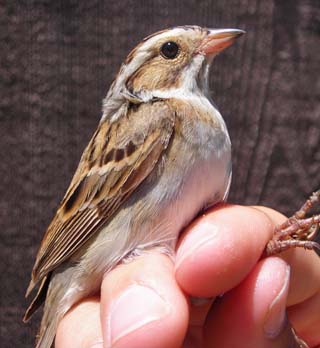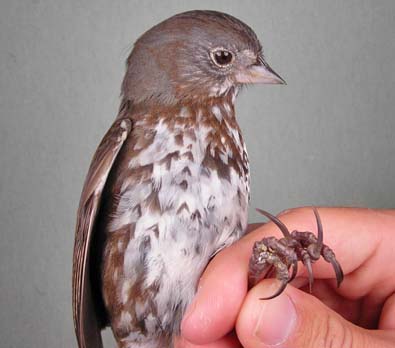| These highlights chronicle the year 2008. Created
incrementally as new photos were available, the year runs generally
"backwards" on this page. Page One chronicled highlights from January through 15 May. |
| The abbreviation "MTY" means "Monterey County"
in the text below. Text by Don Roberson. Photos on this page
are copyrighted by the photographers to whom they are
attributed, and may not be reproduced in any form (including
other web sites) without the express consent of the photographer. |
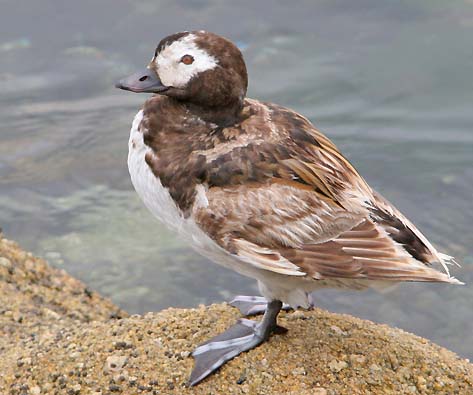 There
is a certain sense of healthy wonderment in being proven wrong. As far
as birds go, it seems that the more I think I know, the less I actually
know. Take the Long-tailed Duck that has been wintering in Monterey harbor. At first there were four, but then it got down to one female. I just reported to North American Birds that "one female continued to linger through May and is summering." I cited "m.ob." as the observers — it was what we all said. There
is a certain sense of healthy wonderment in being proven wrong. As far
as birds go, it seems that the more I think I know, the less I actually
know. Take the Long-tailed Duck that has been wintering in Monterey harbor. At first there were four, but then it got down to one female. I just reported to North American Birds that "one female continued to linger through May and is summering." I cited "m.ob." as the observers — it was what we all said.
I
stopped by the harbor on 17 July. She was still there, but "she" is
molting into a nice male plumage! [Or it looks that way . . maybe I'm
wrong again?] The drake is going through a summer flightless period
and, as Rita Carratello said when she saw this photo (right): it's a
male Short-tailed Duck!
The summering female Harlequin Duck
is also flightless and has molted in new body feathers. In this shot
(below) she is just about the jump into the harbor to forage on
sea-lettuce. |
|
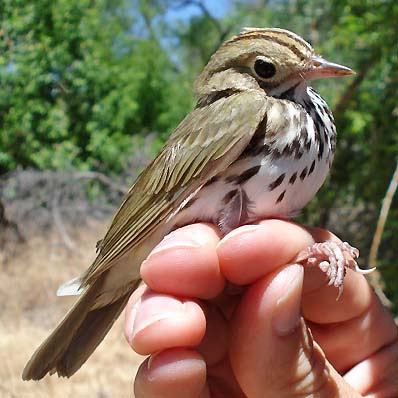 |
Big
Sur Ornithology Lab has an on-going banding program at Camp Roberts,
right near the intersection of the Nacimiento & Salinas rivers, and
just barely north of the San Luis Obispo Co. line. They've had some
interesting summer birds in the past, and 2008 was no exception.
Rarities netted this summer include an Ovenbird on 3 June (left; male in breeding condition) and a Catbird on 26 June (below right; male in breeding condition), both on the Nacimiento, and a summering Golden-crowned Sparrow (below left) from 27 June-3 July on the Salinas River (photos © Ventana Wildlife Society, courtesy Josh Scollen). |
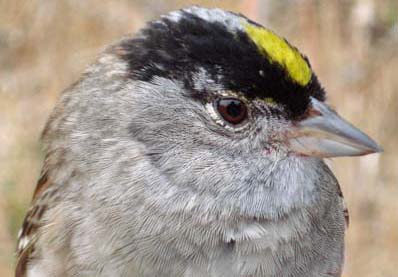 |
|
|

Last spring/summer was the "year of the puffin." This summer may be
turning into the "year of the murrelet." Starting in late June, an
unexpected and early movement of Xantus's Murrelets appeared, many
close to shore (e.g., seen during seawatches from Pt. Pinos or sitting
on the sea at Bird Rock). In early July, a smattering of Marbled
Murrelets appeared. Then on 13 July a pair of Ancient Murrelet
(photo of one above © D. Roberson) were on the water at Bird Rock,
Pebble Beach, and another flew by. One of the pair of Ancients appeared
to be oiled, perhaps explaining its appearance on the water there, but
both were actively diving.
|
Other significant birds of interest in early July were an adult Crested Caracara
along Lapis Road, near Marina, on 4 July (Blake Matheson; could this be
the bird from a few years' back returning?); an alt. pl. Semipalmated Sandpiper near Salinas 8 July (Matt Brady et al.); and a Bobolink in full breeding dress in lower Carmel Valley on 11-13 July (Inga & Dan Lebeaune; photo © Carole Rose, below ).

All could enjoy our local Monterey Bay breeding alcid — Pigeon Guillemot
— as pairs were feeding young at the Monterey harbor (below) or along
Cannery Row throughout this period [photos 7 July © D. Roberson].
|
|
|
|
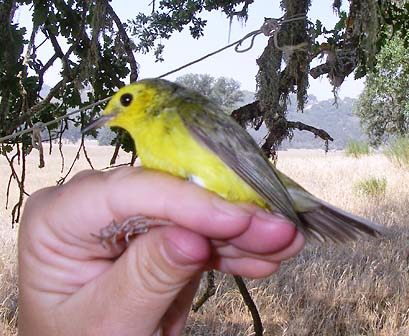 Banders working on a MAPS station on the San Antonio River, just a mile upstream from Lake San Antonio, caught this female Hooded Warbler
on 1 July (left © Darlene Woodbury). The female had a brood patch,
which is considered "confirmed" breeding under breeding bird atlas
standards (but some exceptions are noted in the fine print under this
species in Monterey Birds 2d ed.). Given the date, this bird is likely on a nest. Banders working on a MAPS station on the San Antonio River, just a mile upstream from Lake San Antonio, caught this female Hooded Warbler
on 1 July (left © Darlene Woodbury). The female had a brood patch,
which is considered "confirmed" breeding under breeding bird atlas
standards (but some exceptions are noted in the fine print under this
species in Monterey Birds 2d ed.). Given the date, this bird is likely on a nest.
A
pair of Hooded Warblers at the Big Sur River mouth in summer 2004
fledged one young for the first fully confirmed breeding for MTY.
Another female with brood patch was caught there in June 1994 and may
also have been nesting. |
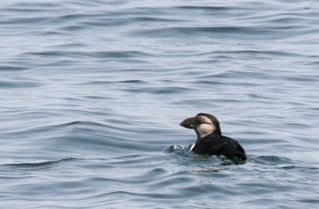
On
27 June, out-of-town Jacob Saucier was very surprised to see a Horned
Puffin inside Monterey harbor! Later that day, a Monterey Bay pelagic
trip found a Horned Puffin, presumably the same one, off Sand City (right, photo © Debra Shearwater). This summer is not nearly like the spring/summer of 2007,
in what might be called as the "year of the puffin," but Brian Sullivan
did see Horned Puffins flying by Pt. Pinos during seawatches on 14
April and 3 July 2008. By early July, a few Xantus's Murrelets were in
the Bay, suggesting an influx of warm water and lots of krill. |
|
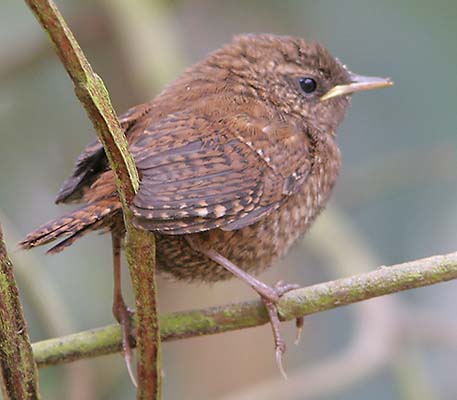 Moonglow
Dairy had a heronry about 60 years ago, according to Louis Calcagno.
This year a new heronry started to develop in late May with a few nests
of Great Blue Heron (above left) and Great Egret
(above right). Meanwhile, the heronry at Elkhorn Slough Nat'l Estuarine
Reserve was doing poorly. This small satellite heronry at Moonglow is
likely composed of failed breeders from ESERR. Moonglow
Dairy had a heronry about 60 years ago, according to Louis Calcagno.
This year a new heronry started to develop in late May with a few nests
of Great Blue Heron (above left) and Great Egret
(above right). Meanwhile, the heronry at Elkhorn Slough Nat'l Estuarine
Reserve was doing poorly. This small satellite heronry at Moonglow is
likely composed of failed breeders from ESERR.
By
early July, 4 of 7 Great Blue Heron nests were still active and 2 had
young [but an adult brought in something too large for the baby, above
left, and ended up eating it itself], but the Great Egret nests seemed
to be failing.
The eucalyptus grove at Moonglow Dairy
is also the only nesting locale for Winter Wren in MTY outside the
redwood groves of the Big Sur coast. The old grove mimics the same
closed canopy. Here's a fledgling Winter Wren (left;
taken 29 June) from Moonglow, so they were successful here again. But
why was a Swainson's Thrush singing here that date? |
|
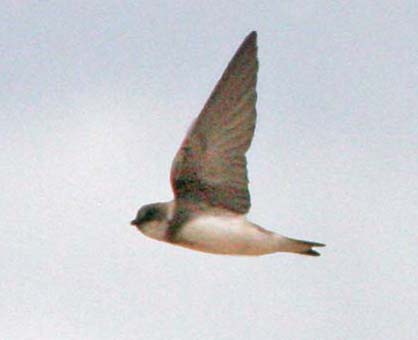 On
Saturday, 21 June, locals were treated to anomalous thunderstorms &
lightening over the Peninsula and Monterey Bay. The storm cell was
moving to the northeast as I took this photo (above) of Rita Carratello
on Ft. Ord State Beach. We were caught in a brief downpour, but we were
here to try to document a newly-discovered colony of Bank Swallow
in Monterey County, located at the remotest portion of the beach (right
& below). As we understand the story from Dave Dixon, the colony
was discovered independently in early June by David Styer and Mary Paul
of State Parks. On our visit, we saw at least 12 adults, some of them
entering or leaving burrows (below). On
Saturday, 21 June, locals were treated to anomalous thunderstorms &
lightening over the Peninsula and Monterey Bay. The storm cell was
moving to the northeast as I took this photo (above) of Rita Carratello
on Ft. Ord State Beach. We were caught in a brief downpour, but we were
here to try to document a newly-discovered colony of Bank Swallow
in Monterey County, located at the remotest portion of the beach (right
& below). As we understand the story from Dave Dixon, the colony
was discovered independently in early June by David Styer and Mary Paul
of State Parks. On our visit, we saw at least 12 adults, some of them
entering or leaving burrows (below).
|
|
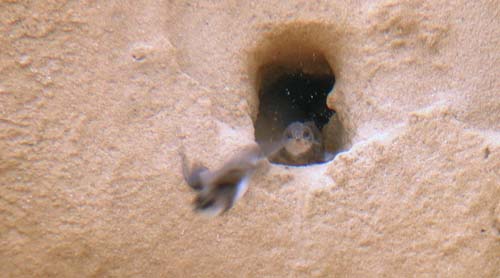 Adults
were observed feeding young in the burrows the following weekend (28
June; D. Styer, Carole Rose et al.). Chris Johnson's digiscoped shot
shows a baby in the nest (left © C. Johnson). With young at this
age, it means the colony was initiated by late April. Adults
were observed feeding young in the burrows the following weekend (28
June; D. Styer, Carole Rose et al.). Chris Johnson's digiscoped shot
shows a baby in the nest (left © C. Johnson). With young at this
age, it means the colony was initiated by late April.
Many
years ago there was a colony on Trafton Road near the Pajaro River
mouth, but those cliffs mostly collapsed in winter 1973-74, and the
colony was abandoned about 1981. The few colonies near King City have
been on the decline; the once-famed Metz Road colony collapsed in the
mid-1990s. Numbers at the San Lorenzo River colony have been down in
recent years. So word of a new local colony of this State-listed
threatened species is very welcome. Alas, the nest sites are within
access of energetic climbers [graffiti appears on the same cliffs], but
the only public access is a hike of 2 or more miles down the sand, so
hopefully they will be safe enough this summer. |
| The
Big Sur River mouth is famous for its vagrant landbirds during spring
& fall migration. On 7 June Big Sur Ornithology Lab banded this Canada Warbler
(right © VWS, courtesy Jessica Griffiths). This is the 2d spring
record for MTY; one was seen here on 8 June 2004. Remarkably, another Canada Warbler
– a male with longer gorget streaks — was seen at Big Sur R. mouth on
18 June (Ryan Terrill). More typical vagrants here this June included
Chestnut-sided Warbler, American Redstart, Indigo Bunting &
Rose-breasted Grosbeak, plus a Western Red Bat flying in the headlands patch at mid-day on 7 June. |
|
| Sometimes we can't really explain why a bird occurs. An example is this light-morph Swainson's Hawk
at Garrapata SP on 13 June (right © Bill Bousman). It is a
migratory bird but June is well after its spring migration. Indeed,
this is the first June record in modern history for MTY. But days later
there was another near Marina on 18 June (M. Tyner). |
|
|
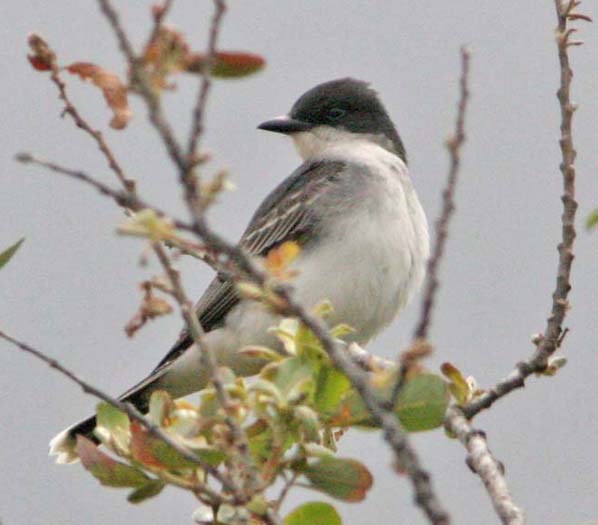 Late May and early June is spring vagrant season. An Eastern Kingbird
(left) at the edge of the headlands patch at Big Sur R. mouth 25 May
was one of those (photo © D. Roberson). Most of MTY's 30+ records
of Eastern Kingbird have been in the fall, but this is the 4th at Big
Sur R. mouth in late May/early June. Late May and early June is spring vagrant season. An Eastern Kingbird
(left) at the edge of the headlands patch at Big Sur R. mouth 25 May
was one of those (photo © D. Roberson). Most of MTY's 30+ records
of Eastern Kingbird have been in the fall, but this is the 4th at Big
Sur R. mouth in late May/early June.
Big Sur Ornithology Lab (BSOL) banded its share of rarities the previous weekend, see the gallery below. |
| The rarest of the vagrants banded by BSOL on 17 May was this male Kentucky Warbler (right), just the 5th MTY record, but a Clay-colored Sparrow that day (below left) was our first ever in spring migration. On 16 May there was a very late Fox Sparrow (below right): it is one of the 'Sooty' forms, and measurements suggest it was either the townsendi or fuliginosa
race, subspecies that do not winter commonly in our county (photos
© Ventana Wildlife Society/BSOL, courtesy Josh Scullen, who also
provided the measurement details). |
|
|
|
|
|
|
TOP
TO HIGHLIGHTS FROM FALL 2007
GO TO
HOME PAGE
TO MONTEREY
COUNTY
PAGE
TO BIRD
FAMILIES
OF THE WORLD
|
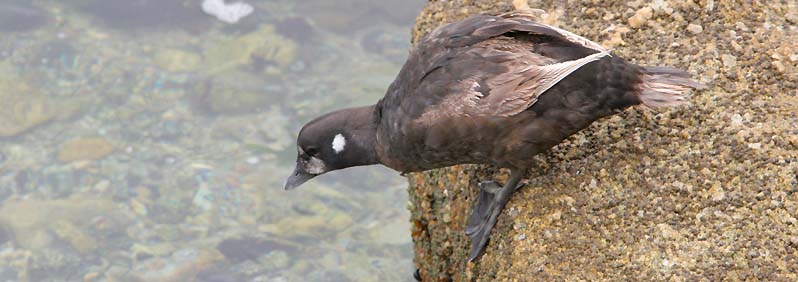
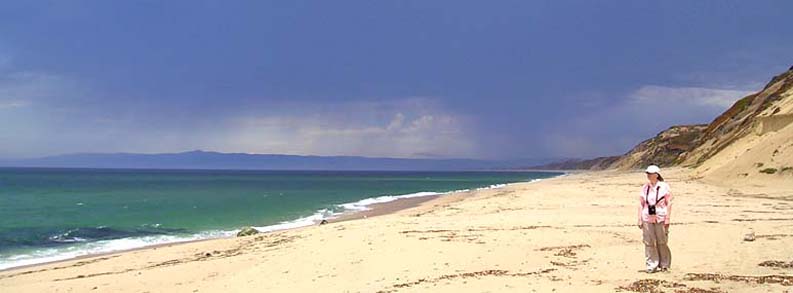
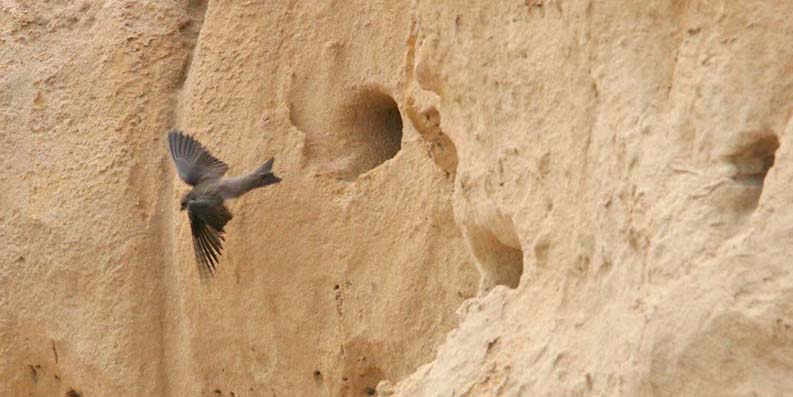
 Late May and early June is spring vagrant season. An Eastern Kingbird
(left) at the edge of the headlands patch at Big Sur R. mouth 25 May
was one of those (photo © D. Roberson). Most of MTY's 30+ records
of Eastern Kingbird have been in the fall, but this is the 4th at Big
Sur R. mouth in late May/early June.
Late May and early June is spring vagrant season. An Eastern Kingbird
(left) at the edge of the headlands patch at Big Sur R. mouth 25 May
was one of those (photo © D. Roberson). Most of MTY's 30+ records
of Eastern Kingbird have been in the fall, but this is the 4th at Big
Sur R. mouth in late May/early June.  There
is a certain sense of healthy wonderment in being proven wrong. As far
as birds go, it seems that the more I think I know, the less I actually
know. Take the Long-tailed Duck that has been wintering in Monterey harbor. At first there were four, but then it got down to one female. I just reported to North American Birds that "one female continued to linger through May and is summering." I cited "m.ob." as the observers — it was what we all said.
There
is a certain sense of healthy wonderment in being proven wrong. As far
as birds go, it seems that the more I think I know, the less I actually
know. Take the Long-tailed Duck that has been wintering in Monterey harbor. At first there were four, but then it got down to one female. I just reported to North American Birds that "one female continued to linger through May and is summering." I cited "m.ob." as the observers — it was what we all said.

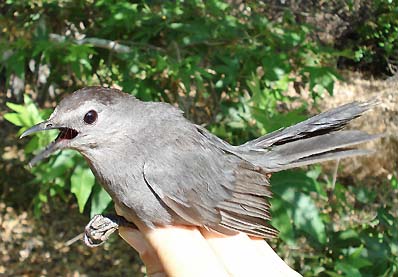


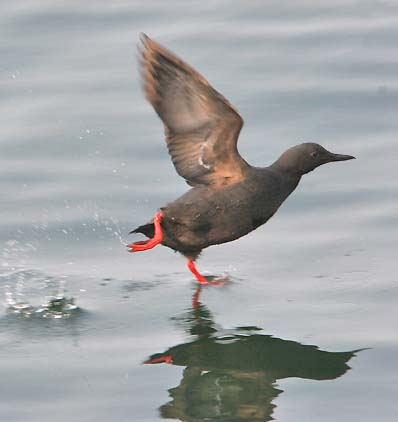
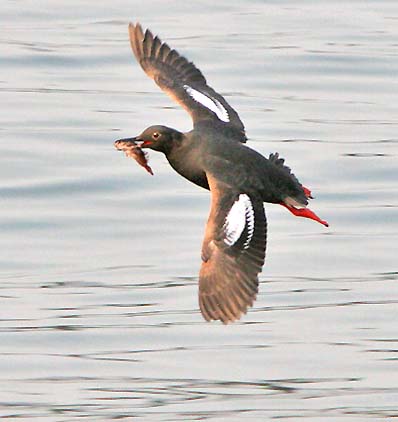
 Banders working on a MAPS station on the San Antonio River, just a mile upstream from Lake San Antonio, caught this female Hooded Warbler
on 1 July (left © Darlene Woodbury). The female had a brood patch,
which is considered "confirmed" breeding under breeding bird atlas
standards (but some exceptions are noted in the fine print under this
species in Monterey Birds 2d ed.). Given the date, this bird is likely on a nest.
Banders working on a MAPS station on the San Antonio River, just a mile upstream from Lake San Antonio, caught this female Hooded Warbler
on 1 July (left © Darlene Woodbury). The female had a brood patch,
which is considered "confirmed" breeding under breeding bird atlas
standards (but some exceptions are noted in the fine print under this
species in Monterey Birds 2d ed.). Given the date, this bird is likely on a nest. 
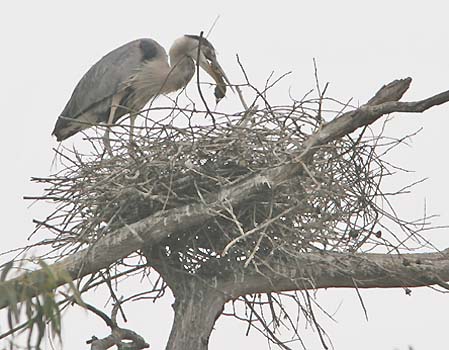
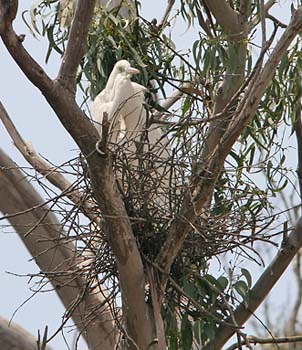
 Moonglow
Dairy had a heronry about 60 years ago, according to Louis Calcagno.
This year a new heronry started to develop in late May with a few nests
of Great Blue Heron (above left) and Great Egret
(above right). Meanwhile, the heronry at Elkhorn Slough Nat'l Estuarine
Reserve was doing poorly. This small satellite heronry at Moonglow is
likely composed of failed breeders from ESERR.
Moonglow
Dairy had a heronry about 60 years ago, according to Louis Calcagno.
This year a new heronry started to develop in late May with a few nests
of Great Blue Heron (above left) and Great Egret
(above right). Meanwhile, the heronry at Elkhorn Slough Nat'l Estuarine
Reserve was doing poorly. This small satellite heronry at Moonglow is
likely composed of failed breeders from ESERR.  On
Saturday, 21 June, locals were treated to anomalous thunderstorms &
lightening over the Peninsula and Monterey Bay. The storm cell was
moving to the northeast as I took this photo (above) of Rita Carratello
on Ft. Ord State Beach. We were caught in a brief downpour, but we were
here to try to document a newly-discovered colony of Bank Swallow
in Monterey County, located at the remotest portion of the beach (right
& below). As we understand the story from Dave Dixon, the colony
was discovered independently in early June by David Styer and Mary Paul
of State Parks. On our visit, we saw at least 12 adults, some of them
entering or leaving burrows (below).
On
Saturday, 21 June, locals were treated to anomalous thunderstorms &
lightening over the Peninsula and Monterey Bay. The storm cell was
moving to the northeast as I took this photo (above) of Rita Carratello
on Ft. Ord State Beach. We were caught in a brief downpour, but we were
here to try to document a newly-discovered colony of Bank Swallow
in Monterey County, located at the remotest portion of the beach (right
& below). As we understand the story from Dave Dixon, the colony
was discovered independently in early June by David Styer and Mary Paul
of State Parks. On our visit, we saw at least 12 adults, some of them
entering or leaving burrows (below). Adults
were observed feeding young in the burrows the following weekend (28
June; D. Styer, Carole Rose et al.). Chris Johnson's digiscoped shot
shows a baby in the nest (left © C. Johnson). With young at this
age, it means the colony was initiated by late April.
Adults
were observed feeding young in the burrows the following weekend (28
June; D. Styer, Carole Rose et al.). Chris Johnson's digiscoped shot
shows a baby in the nest (left © C. Johnson). With young at this
age, it means the colony was initiated by late April. 